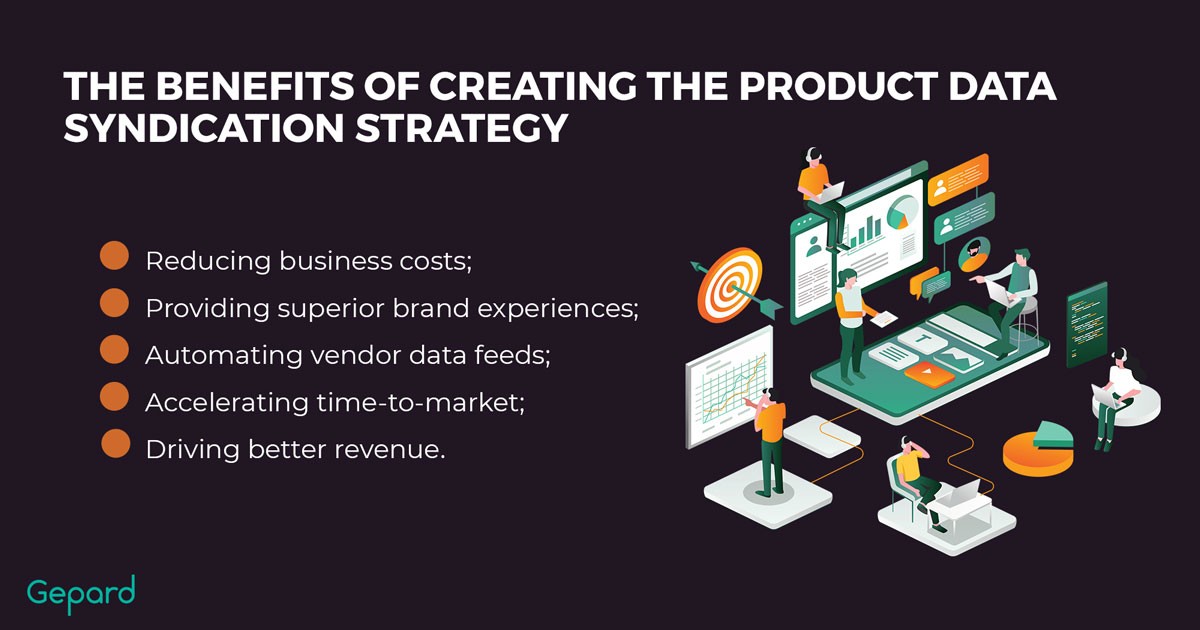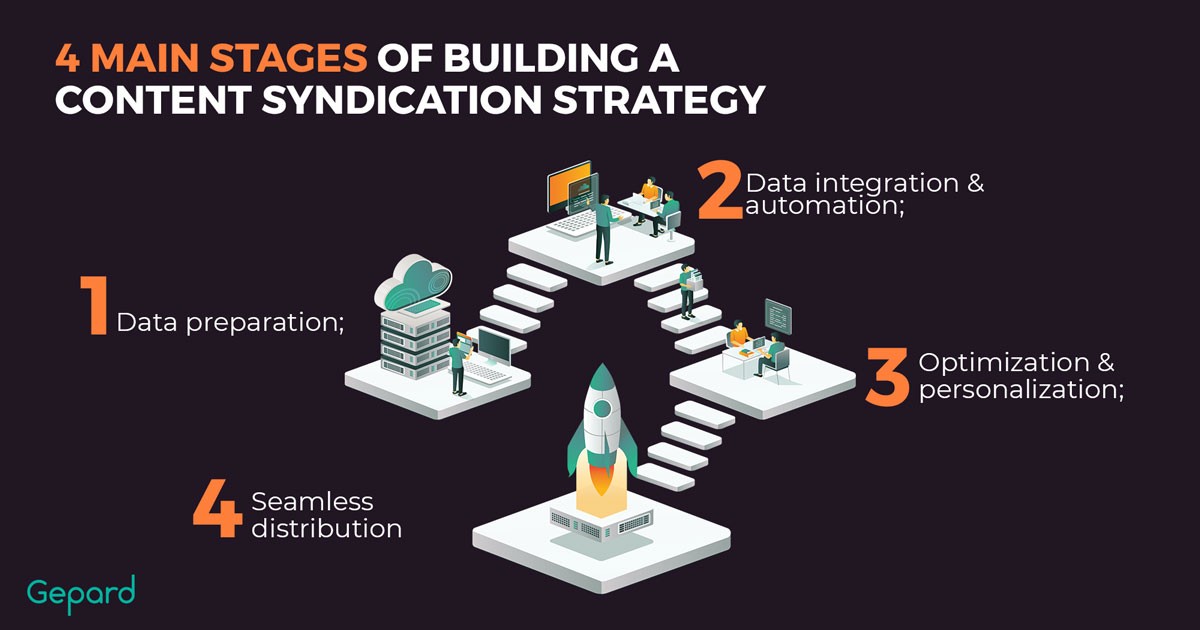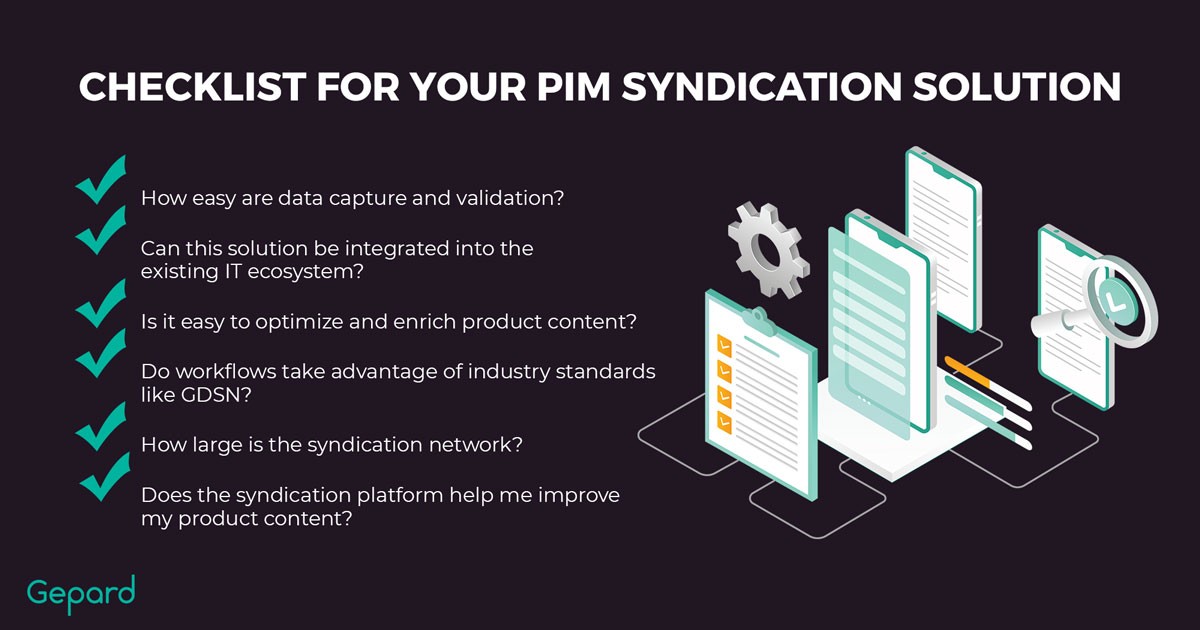Product Data Syndication Strategy: What It Is & How It Works
Product data syndication strategy is often regarded as the key to successful eCommerce performance. Marketing is what gets your product out there, but presenting it across multiple sales channels with a consistent description via automation tools is what solidifies consumer trust, which results in brand loyalty.
With just about every aspect of our society being digital nowadays, consumers have a strong expectation of easy access to any information out there. Statistics show that 20% of overall unsuccessful purchases in eCommerce are due to poor product descriptions. A well-thought-out process of information distribution to different marketplaces that follows all content guidelines is one way of lowering that 20% mark—in other words, having a product data syndication strategy.
What Is A Product Data Syndication Strategy?
The Goals Of A Product Data Syndication Strategy
Having an effective product data syndication strategy helps businesses secure a consistent customer experience across all sales channels. To achieve this, businesses should focus on:
- Understanding consumer psychology. Analyze how buyers make purchasing decisions, particularly in your niche. For instance, customers purchasing high-end electronics may prioritize detailed specifications, brand reputation, and warranty information. Companies like Apple use premium branding and detailed product storytelling to appeal to their target market’s emotional and practical needs.
- Optimizing content consumption preferences. Ensure that syndicated brand data is engaging and aligned with consumer needs. For example, fashion retailers like Zara optimize product descriptions with high-quality images, size charts, and user-generated reviews, helping customers make informed purchasing decisions. In contrast, technical B2B platforms like Mouser Electronics ensure data sheets and technical specifications are well-structured for professional buyers.
“As a brand, you want to care about merchandising optimally for each retailer. You want to care about telling your brand story in a way that works with the retailer strategy – that works for the demographics that shop on that retailer – and that means one-size-fits-all does not work for you. Syndication can help with this.” Rob Gonzalez, E-Commerce Expert & CEO
- Choosing the right communication channels. Identify where customers engage most and tailor syndication for product information accordingly. For example, a beauty brand like Fenty Beauty focuses on Instagram, TikTok, and Sephora’s online store, using visual storytelling and influencer marketing. Meanwhile, an industrial supplier may prioritize Amazon Business, LinkedIn, and specialized procurement portals.
- Maintaining continuous content review. Keep product information updated to meet evolving marketplace standards and customer expectations. An example is Walmart’s marketplace, which regularly updates product attribute requirements. Brands selling on Walmart must continuously refine their listings to maintain compliance and ensure visibility in search results.
To achieve all of this, the best way to go is using powerful product content management solutions that ensure accurately syndicated data, optimized and exported to the right place at the right time and in the right format.
The Benefits Of A Product Data Syndication Strategy
A well-structured product syndication strategy provides core business growth benefits. For online retailers, this is especially the case, as successfully dealing with multiple third-party sales platforms requires a lot of time and resources.
- Automating vendor data feeds
Having your online shop communicate with a marketplace is seamless with a strong syndication strategy that automatically dispenses all of the product data feed from your inventory once it is set up.
- Reducing costs
Automating the distribution of your product content results in cutting expenses as the human error factor is eliminated and the entire process becomes much faster when done by a PIM syndication solution.
- Providing superior brand experiences
Having your products visible in a consistent way through different well-known platforms, such as Amazon, Asos, Zalando, etc., strengthens your brand as these platforms and their users add credibility to your business.
“Besides arranging to be on platforms and sites, brands benefit from product content syndication because it supports consistent customer experiences across touch points, facilitating both audience trust and brand loyalty. When automated, the process accelerates time to market and reduces the likelihood of errors. This is definitely beneficial for any business.” Nathan Holmes, Senior Manager, Product Marketing at Acquia
- Accelerating time to market
With a strong syndication strategy in place, product manufacturers and retailers can accurately supply content to eCommerce platforms in a single automatic manner that meets all of the individual data supply requirements and subsequently speeds up the product launch.
- Driving higher revenue
The faster the product is placed on the market, and in more places, results in strengthening the overall revenue flow as sales are coming from different sources.

The Main 4 Stages Of Product Data Syndication Strategy
1. Data Preparation
Raw data is inherently unstructured and must be organized properly for effective syndication and seamless integration into various product feeds The process of preparing a product database consists of three essential steps:
- Centralization
In today’s society where everything is digital, there are multiple points of data. Before any information can be processed and worked on, an online business first needs to collect all of its data in one consolidated storage spot.
- Enrichment
For any eCommerce business, a strong product description is a big driving factor. An online retailer can set up hundreds of ad campaigns with powerful messaging that drives traffic, but if the product description is not right, all of the marketing is worth nothing. This is exactly where the enrichment stage comes in. Once all the data is centralized, it can be analyzed and compared with the competitors’ data, and any missing information can be added. Additionally, putting yourself in the place of a customer is another way of finding those important product attributes that will push that “Add to Cart” action.
- Validation
Once all of the information is enriched, it’s time to validate the data. Before any distribution of syndicated sales data and brand information takes place, it’s important to check the consistency and accuracy of the information being listed, and above all check that it conforms with all of the requirements of the platforms that it is being loaded to.
2. Data Integration And Automation
Automation saves time and resources for online businesses and is often the solution to many tasks that are in fact growth obstacles. One of them is the collection and standardization of product data.
By making the whole process of data integration automatic, which is essentially pulling information from different sources, performance efficiency can be increased, valuable resources are saved, and those resources can be allocated to other prime tasks.

3. Optimize And Personalize
Before any product catalog can turn into fully syndicated content and appear on the desired third-party platforms, it needs to be optimized so it can maximize the performance on every channel and in every market that it appears on.
Testing the performance of the data on each channel is one of the most important stages. It gives you an opportunity to get real user analytical reports with actual market dynamics of how each page performs, its click-through rate, time-on-page and all other metrics that will suggest where final personalized improvements need to be made.
4. Seamless Distribution
Once optimized, product data syndication begins. Reliable product content management solutions enable automated publishing to eCommerce, retail, and business channels.
Using PIM software will make this process seamless as you are able to set a comprehensive publishing schedule for each channel.
Additionally, you don’t have to worry about any formatting issues as any sophisticated software will adjust the datasets to the required format of the destination.
Checklist For Your PIM Syndication Solution
To ensure error-free and efficient operations, focus on the features of a product data syndication platform that go beyond content export, integrating seamlessly with business systems and streamlining workflows. When selecting a PIM solution, consider the following:
How easy are data capture and validation?
An advanced PIM syndication solution should be able to collect information and convert it for readability by any other platform that it is being loaded to. If there is no automatic transformation functionality, then you will be required to use an additional SaaS that does it. This will make the whole process insufficient and highly prone to error.
Can this solution be integrated into the existing IT ecosystem?
Every business has a specific tool stack that it works with and it’s crucial that the solution you are choosing has integration capabilities with those tools. Besides being more convenient and saving time, this will also help you in avoiding employee onboarding training.
Is it easy to optimize and enrich product content?
No content is static and is always changing in relevance with time and the same goes for product descriptions. Having the ability to optimize and enrich your data with the right solution will save you time and set you free from deleting a particular listing and uploading it with new attributes.
“With product data syndication, you can do away with the manual complexities of updating product details on every platform or sales channel. You can instead update all relevant information related to your product catalogue into a single source which then automatically funnels into your connected channels.” Pradyut Hande, Head of Product Marketing & Analyst Relations
Do workflows take advantage of industry standards like GDSN?
Having a software solution that follows different industry standards will guarantee the ease and security of exchanging data with counterparts and is a powerful benefit for product data handling. When it comes to taking advantage of industry standards, these are among the most important out there:
- GDSN (Global Data Synchronization Network) is one of the core standards that companies use when standardizing product information with their trade partners. It is considered as the world’s largest product data network and is administered by GS1.
- EPREL (European Product Database for Energy Labelling) is a relatively new regulatory body within the EU that provides its consumers with relevant and safe energy efficiency information on consumer electronic products. Any global retailer that wishes to sell electric products on the EU market has to follow EPREL’s guidelines.
- ETIM (European Technical Information Model) is a leading international standard for product classification for industrial businesses in installation, building and construction machinery. Following the ETIM standard allows businesses in the above fields to improve data management and simplifies its exchange with minimum errors.
- Applia PI-Standard lays out a flow of electronically transferring product data information for home appliances. With its reliable structure, the standard allows European manufacturers to universally share information between each other and the consumer market.

How large is the syndication network?
No matter the size of your business, selecting a platform that has a large syndication network is vital. A business might be working only with one or two sales channels at the moment, but as it grows, naturally it will need to have its product on additional marketplaces. Switching between different syndication software can be a costly project—thus, it’s best to go with the one that has a large network from the get-go.
Does the syndication platform help me improve my product content?
The bottom line of using any software in your business is that it improves processes and strengthens your overall company performance. The same goes for syndication solutions—you should have the ability to refine your product content.
Product Data Syndication: Best Practices
Boosting product visibility starts with the right approach. We prepared some interesting cases for you featuring best practices in product data syndication to streamline distribution and drive sales.
How Grover Transformed Tech Rentals with Smart Product Data Syndication
Grover, Europe’s leading tech rental platform, offers flexible subscriptions for gadgets like laptops, cameras, and smart devices. As their catalog grew, managing product data manually became inefficient, leading to inconsistencies and delays. To improve operations, they integrated Gepard PIM, automating imports, enriching content with Icecat connectors, and structuring exports to fit their unique Grading System.
With syndication for product information, Grover ensured accurate product listings across multiple channels. Gepard Compliance helped maintain marketplace standards, while Gepard Digital Shelf provided real-time insights into product catalog performance. The result? Faster product updates, reduced manual effort, and a more seamless rental experience, proving that a strong product data syndication strategy is key to scaling a tech rental business.
Migros Boosts eCommerce Efficiency with Automated Syndicated Sales Data
As Switzerland’s largest supermarket chain, Migros faced a growing challenge – managing syndicated sales data from suppliers like Icecat and Xplace while ensuring it fit their unique product taxonomy. Manual adjustments were time-consuming, errors-prone, and slowed down product updates.
With Gepard PIM solution, Migros automated syndication for product information, transforming incoming data in real-time to match their system’s structure. The platform also enabled multilingual support in German, French, and Italian, making product localization faster and more efficient.
Now, product updates are quicker, data is accurately structured, and Migros can focus on expanding its eCommerce presence without the hassle of manual corrections.
How Samsonite Leveraged Content Syndication for Greater Reach
Samsonite, a global leader in travel gear, needed a way to maximize the reach of its branded and influencer-generated content across multiple retail platforms. To achieve this, the company partnered with Bazaarvoice, implementing content syndication to distribute high-quality visuals and user-generated content (UGC) to retailer websites.
By integrating Bazaarvoice Galleries, Samsonite transformed product pages with dynamic content while ensuring consistent messaging across all retail partners. This strategy resulted in higher customer engagement, a 4x increase in conversion rates, and a 254% revenue boost, which demonstrated the power of content syndication in expanding brand reach and influencing purchase decisions.
How Samsung Powers Global Sales with Product Content Syndication
Samsung makes sure its products look great and have the right information everywhere they are sold. By sharing clear descriptions, high-quality images, and correct details on sites like Amazon, Best Buy, and Walmart, Samsung keeps shopping easy for customers and hassle-free for retailers. Instead of making store partners update everything by hand, Samsung’s system does it automatically, so shoppers always see the most up-to-date and accurate details.
A big part of this is Samsung’s Partner Marketing Hub, which gives retailers ready-to-use ads, email templates, and social media posts to help promote products. When Samsung launches something new, like the Odyssey OLED G8 Gaming Monitor, it makes sure all the right details and pictures show up on every store’s website at the same time. This not only helps Samsung but also makes things easier for stores, speeds up sales, and keeps customers happy by giving them the same great experience no matter where they shop. In short, Samsung’s approach isn’t just about sending out product info – it’s about making shopping simple, fast, and trustworthy for everyone.
Product Data Syndication Strategy FAQ
When Does eCommerce Need A PIM Syndication Solution?
If you are operating an online shop that sells an extensive amount of products across a number of platforms and need to scale further by improving your process, a PIM solution is a necessity for this to happen.
“A well-structured product syndication strategy provides core business growth benefits. For online retailers, this is especially the case, as successfully dealing with multiple third-party sales platforms requires a lot of time and resources.” Sergii Shvets, eCommerce specialist and CEO at Gepard
How Does The PIM Software Work?
The way a PIM tool functions is by collecting data from multiple locations and generating one joint record for each product with all of its possible attributes. A designated user has access to the records and the ability to update them and of course can upload the description to various platforms in an automatic manner.
Where Do I Start If I Want To Create A Product Data Syndication Strategy For My Company?
The first stage would be performing an analysis of your inventory and where it is being sold. Another stage is understanding the issues you are facing from the analytical information available. Consulting a company that deals with data syndication as a service will help you determine the right direction as well.
How Gepard Helps Online Retailers Devise A Product Data Syndication Strategy
Building a successful syndication strategy that delivers results takes time and effort. The outcome that you want is a consistent shopping experience for your customers, no matter where their interaction with your products takes place.
Using Gepard PIM syndication solution in your data management tasks will help in getting rid of incomplete information patterns, performing product content analysis and incorporating channel-specific enhancements. Moreover, you will be able to automatically publish refined content and in return eliminate the risk of inaccurate product information across the distribution chain in an economical and efficient way.
Furthermore, Gepard can help your business build an effective and scalable product data syndication strategy and provide professional support at all implementation stages.
Want to learn how to build a winning product data syndication strategy? Request a free consultation with one of our professionals today.

